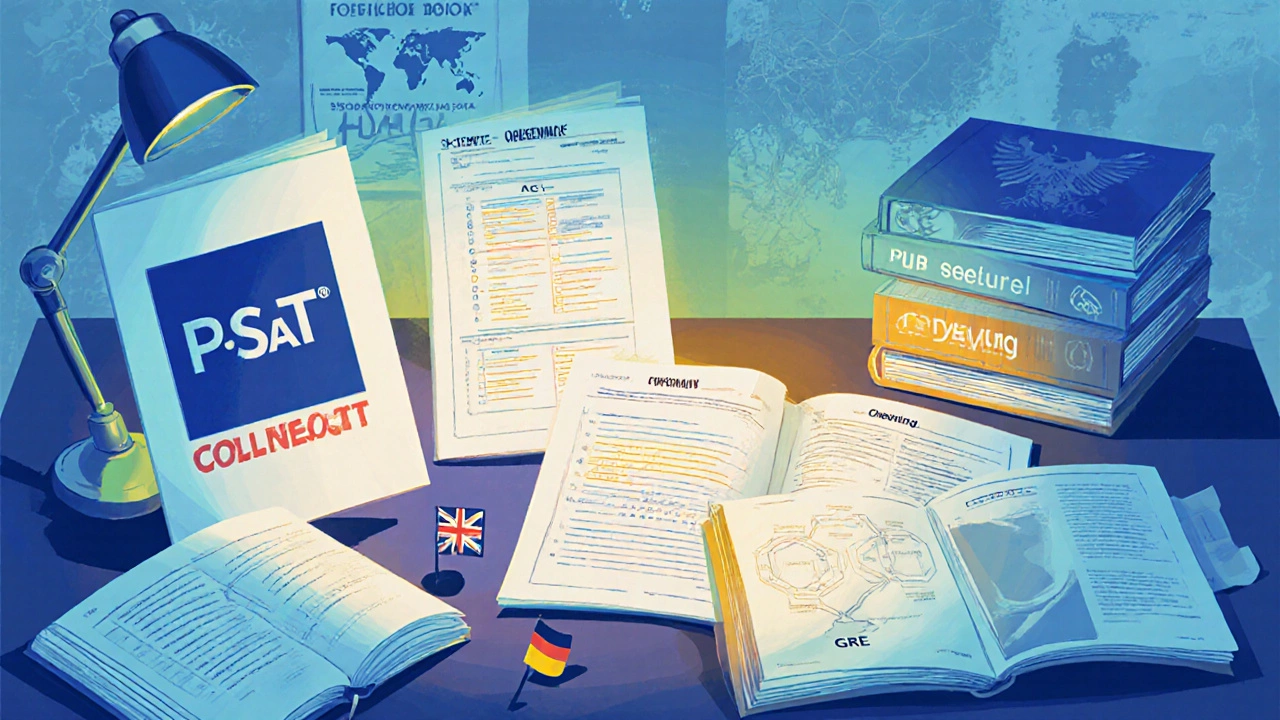
Scholarship Test Selector
Recommended Scholarship Test
Popular Scholarship Tests
PSAT/NMSQT
U.S. High School Merit
SAT
U.S. College Entrance
ACT
U.S. College Entrance
Commonwealth
UK Graduate
DAAD
German Research
Chevening
UK Leadership
Fulbright
U.S. Research
Students everywhere wonder which exam can open the biggest scholarship doors. The answer isn’t a single test but a handful of exams that carry the most weight with funding bodies. Below you’ll find the top scholarship tests, how to pick the right one for your goals, and practical tips to ace them.
Key Takeaways
- The scholarship test that matters most depends on your region, field of study, and the type of funding you seek.
- PSAT/NMSQT, SAT, and ACT are the gateway exams for most U.S. merit‑based scholarships.
- National Merit, Commonwealth, DAAD, Chevening, and Fulbright each have their own qualifying exams or assessments.
- Choose a test by matching its eligibility criteria, score requirements, and subject focus with your academic plan.
- Start early, use official practice tools, and simulate test conditions to improve your score.
Top Scholarship Tests Worldwide
These exams are repeatedly cited by major scholarship programs as the primary selection tool.
PSAT/NMSQT is the Preliminary SAT/National Merit Scholarship Qualifying Test, administered to high‑school sophomores and juniors in the United States. A high score can qualify you for the National Merit Scholarship and many university‑specific merit awards.
SAT is a standardized test measuring reading, writing, and math skills. Many U.S. colleges use SAT scores to award merit‑based scholarships, especially when combined with GPA and extracurriculars.
ACT covers English, math, reading, and science reasoning. Like the SAT, ACT scores are a major factor for many merit scholarships across American institutions.
National Merit Scholarship is not a separate test but a program that uses PSAT/NMSQT scores to select eligible students for scholarships ranging from $2,500 to full‑ride awards.
Commonwealth Scholarship Exam covers a written assessment and interview for candidates from Commonwealth countries applying for graduate study in the UK. Academic excellence and leadership potential are measured.
DAAD Scholarship Test is a German Academic Exchange Service assessment used for certain research scholarships. It evaluates subject‑specific knowledge and German language proficiency.
Chevening Scholarship Assessment includes a written essay and interview designed to gauge leadership, networking skills, and academic readiness for postgraduate study in the UK.
Fulbright Scholar Program Test relies on a combination of GRE scores, TOEFL/IELTS, and a detailed personal statement to select candidates for U.S. study and research grants.

How to Choose the Right Test for Your Scholarship Goal
- Identify the scholarship pool you target. If you aim for U.S. undergraduate merit aid, the PSAT, SAT, or ACT are essential. For postgraduate study abroad, focus on Commonwealth, DAAD, Chevening, or Fulbright criteria.
- Check eligibility windows. PSAT is only offered in October/November, while SAT/ACT have multiple dates throughout the year. International exams often have annual cycles.
- Match subject focus. Science‑heavy scholarships may prefer ACT’s science reasoning section, whereas humanities scholarships may weigh SAT reading and writing more heavily.
- Consider language requirements. DAAD and Fulbright require proof of German or English proficiency; many programs accept TOEFL or IELTS scores.
- Look at score thresholds. National Merit typically needs a PSAT score in the top1percent; Chevening essays are evaluated qualitatively.
Effective Preparation Strategies
- Start early. Give yourself at least six months of consistent study before the test date.
- Use official practice materials. The College Board (for SAT/PSAT) and ACT.org provide free sample questions that mirror actual test difficulty.
- Simulate test conditions. Take full‑length timed practice tests in a quiet environment to build stamina.
- Focus on weak areas. Analyze your practice results and allocate extra time to the sections where you lose the most points.
- Learn test‑taking tricks. For SAT, mastering “grid‑in” strategies for math; for ACT, practicing rapid reading techniques.
- Seek feedback for essay‑based assessments. Chevening and Fulbright essays benefit from mentor reviews to sharpen clarity and impact.

Resources and Study Materials
Below is a quick‑reference table of the most trusted resources for each exam.
| Test | Official Site | Free Practice | Score Reporting |
|---|---|---|---|
| PSAT/NMSQT | College Board | Daily Practice App | College Board Score Report |
| SAT | College Board | Official Practice Tests | College Board Score Report |
| ACT | ACT.org | ACT Test Prep App | ACT Score Report |
| Commonwealth | Commonwealth Scholarship Commission | Sample Assessment Papers | UK NARIC Evaluation |
| DAAD | DAAD.de | Subject‑specific Sample Tests | DAAD Score Dashboard |
| Chevening | Chevening.org | Essay Guide & Sample Questions | Chevening Application Portal |
| Fulbright | Fulbrightprogram.org | GRE/TOEFL Official Guides | Fulbright Online Portal |
Common Pitfalls to Avoid
- Waiting until the last minute to register-many scholarship programs close applications weeks before the test date.
- Ignoring the essay component-Chevening and Fulbright place heavy weight on personal statements; a weak essay can nullify a high test score.
- Focusing only on raw scores-most merit scholarships also consider GPA, extracurricular leadership, and community impact.
- Neglecting language proficiency-non‑native speakers often underestimate the TOEFL/IELTS impact on Fulbright eligibility.
- Skipping official practice-unofficial resources may misrepresent difficulty and timing.
Frequently Asked Questions
Which test gives the highest chance of winning a full‑ride scholarship?
In the United States, a top‑percentile PSAT/NMSQT score that earns National Merit recognition often leads to full‑ride offers from many private colleges. Internationally, the Chevening essay and interview are decisive for UK full‑funded scholarships.
Can I use the same SAT score for multiple scholarships?
Yes. Most U.S. merit scholarships accept any official SAT score report, provided the test date falls within the scholarship’s eligibility window.
Do I need a separate test for the Fulbright scholarship?
Fulbright does not have a unique written test; it relies on GRE (or subject‑specific equivalents) and TOEFL/IELTS scores, plus a detailed personal statement and reference letters.
How early should I start preparing for the PSAT/NMSQT?
Ideally 9-12 months ahead. Starting a year before the test lets you master content, practice timed sections, and improve your score gradually.
Are scholarship tests the same as college entrance exams?
Often they overlap. In many countries, the scores that get you into college also serve as the primary metric for merit‑based scholarships, but some programs add extra assessments (essays, interviews) to differentiate candidates.





